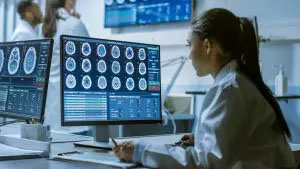As COVID-19 continues to rapidly spread around the world, scientists are scrambling to identify diagnostics, therapeutics, and vaccines that can help put a stop to the relentless outbreak. To help expedite the extensive clinical trial process, many biotech firms are working with contract research organizations (CROs) to quickly identify real-world evidence (RWE) and real-world data (RWD) as proof points for the efficacy of certain drugs. For a quick refresher on Research 101, RWE is clinical evidence that points to the potential benefits and/or risks of a medical product. RWD is data that’s routinely collected from a variety of sources to show how a population’s health status has subsequently evolved over time.
Why this heightened focus on RWE and RWD?
One obvious factor is the U.S. Food and Drug Administration (FDA). In 2016, Congress passed the 21st Century Cures Act. This law was designed to help accelerate medical product development and bring new innovations to patients who need them faster. Under this law, Congress mandates the FDA’s use of digital data to make regulatory decisions and maintain post-market safety. And what, you might ask, is a prime example of digital data that can be used as RWE/RWD? You guessed it—medical imaging!
 Yes, those CTs, MRIs, ultrasounds, PET scans, and so on that are stored in various data repositories play an increasingly important role as RWE/RWD for clinical trials. A few prime applications include:
Yes, those CTs, MRIs, ultrasounds, PET scans, and so on that are stored in various data repositories play an increasingly important role as RWE/RWD for clinical trials. A few prime applications include:
So RWD/RWE is critical for biotech advancements, and imaging is a great resource. What’s the problem?
Two words: imaging liquidity.
At a high level, imaging liquidity refers to the ability to store images and their associated metadata (those hundreds of rich-data fields that accompany your images) in ways that are easily searchable and accessible throughout the enterprise and via your software systems of choice. The challenge with imaging liquidity, however, is that the various imaging software systems that most CROs or biotech firms rely on are not interoperable. As a result, it is extremely challenging, if not impossible, to use these systems to search, locate, and save the images that can serve as RWD/RWE during a clinical trial.
Is there a way for imaging data to be searchable and accessible to those who need it for drug development?
Fortunately, there is a solution that can link all health IT systems and allow seamless access to the complete patient-imaging record. The solution is known as a vendor-neutral archive, or VNA. Widely familiar in the enterprise-imaging arena, though often a foreign concept to those in the biotech or clinical research space, a VNA bypasses the need to switch CROs or pursue the dreaded system rip-and-replace method. Instead, the VNA simply optimizes and unifies the systems already in place to provide the complete patient-imaging record to those who need it.
How does a VNA work?
The top VNAs can run on-site or in the cloud, and they employ the latest industry standards, including DICOM, DICOMweb, HL7, FHIR, XDS, and RESTFUL Web services, to seamlessly exchange information between systems. They then extract exact copies of images and the associated metadata from the source systems and store them in secure, standard formats so the data is accessible to the CRO or biotech firm’s software systems.
Remember that term “imaging liquidity?” That’s what a VNA enables for the biotech sector. By indexing all the metadata, hundreds of thousands of images can easily be searched in seconds, allowing CROs and their biotech counterparts to quickly locate and use the information they need to help fuel biotech breakthroughs.
Where can I learn more?
Interested to know more about how a VNA can bring complete imaging value to your clinical trial? Be sure to download our white paper from the TeraMedica Division of Fujifilm, and contact us directly to schedule a demo of our industry-leading Synapse® VNA.